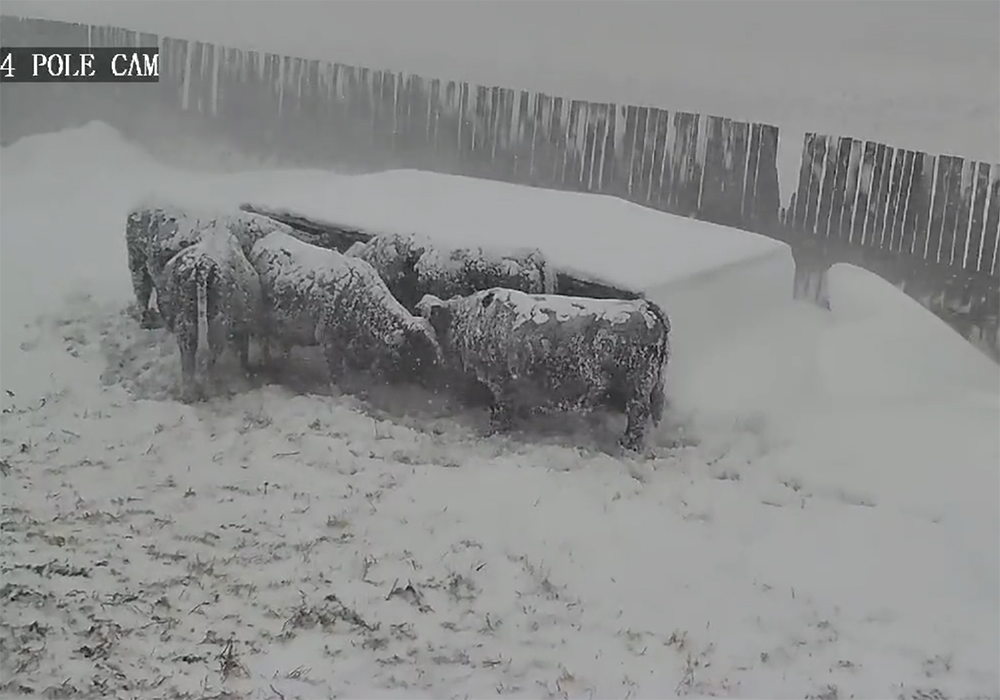Manitoba’s lambs have been decimated, about 3,000 calves are dead, and honeybee colonies are being ravaged as Manitoba producers continued to struggle through a fourth spring storm that hit May 9.
“To have the hopes of a new crop of lambs or calves dashed in a weekend blizzard event on top of everything else is mental trauma at another level,” said Morgan Moore, chair of Manitoba Sheep.
The first storm was a blizzard, which caused deaths to animals on pasture and outdoor situations from multiple causes. The second storm was a mix of snow and heavy rain. The third was mostly rain. The fourth is rain.
The first storm also led to the deaths of 2,000 hogs in a barn that lost power, saw its backup generator fail, and which was surrounded by too much snow and water to allow staff to reach it in time to save the animals.
“During extremely challenging and lengthy weather conditions, which resulted in highway closures, travel advisories and dangerous driving conditions, our employees were not able to access one of our sites,” said Dave Penner, chief operating officer of Hylife’s hog farm unit, in a statement.
Some honey operations have been flooded, causing some colonies to be submerged, others to be inaccessible for necessary disease prevention treatment and maintenance, and others to be hit by scrounging bears.
While farmers scramble to control the damage, Manitoba’s farm organizations are asking governments to do what they can to help farmers survive and recover from this present calamity, which follows a harsh winter and an extended drought.
Keystone Agricultural Producers “is focused on hearing from the grassroots during this difficult time,” said Brenna Mahoney, executive director of KAP.
“Farmers are prepared to deal with weather challenges but the current situation is even more difficult as there have been multiple shocks.”
The organization is compiling estimates of farm losses as it talks to government, surveying the damage to multiple sectors of agriculture as the most severe stretch of spring storms in decades extends the pain for producers. Hard numbers will be difficult to know for weeks.
Manitoba Beef Producers general manager Carson Callum is anxiously watching for the lingering effects of these storms on Manitoba’s newborn calf crop. Beyond the initial shock of calf deaths, wet and cold weather can massively increase the chance of calves developing pneumonia — a common calf killer.
“The disease pressure grows exponentially when there’s the additional moisture and then dips in temperatures,” said Callum.
For sheep producers, about 10 percent of the provincial lamb crop has been killed by the storms, with some producers facing higher losses.
“The cold and now the wet has not been good for the herds,” said Moore.
Interlake beekeeper Paul Gregory said the weather has created a nightmare for farmers.
“High flood waters have made it almost impossible to reach some beeyards,” said Gregory. “This has resulted in honeybee colonies not being fed and treated in a timely manner. We have had four black bear hits because predator fencing could not be done.”
For crop growers, yet another rainstorm adds to overland flooding, fertilizer losses, washed out roads and much delayed seeding. The moisture is welcome where it can sink in, but huge acreages were underneath a plain of water as the fourth storm hit.
The irony is that most farmers will still need moisture after this, just not for a few weeks. Virtually everywhere subsoil moisture levels are badly depleted. Moisture is not only needed to get the crop germinated, but also to recharge soil beds that have dried out after two years of drought.
















